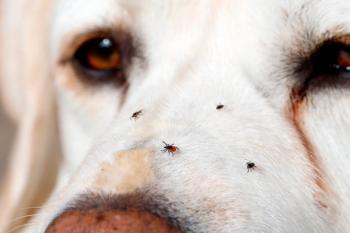
What's new in dermatologic disease: Drugs and pathogenesis of canine atopic dermatitis
The pathogenesis of canine atopic dermatitis is complex and our understanding of it continues to change and advance.
The pathogenesis of canine atopic dermatitis is complex, and our understanding of it continues to change and advance. For years we have been moving away from the concept of inhaled allergies being the main cause of atopic dermatitis, instead recognizing that atopic dermatitis is predominantly a cutaneous reaction to allergens that directly interact with the skin. Multiple research projects have shown that the main, most likely route of sensitization is through the skin.
Sensitization and development of allergy involves much more than IgE production and stimulation of mast cells. The role of the skin's immune system, with activation of Langerhans cells and T cells, became an important target of interest and research and this did advance our knowledge. Eosinophils, once believed to be unimportant, are involved in the inflammatory reaction and are significantly increased in the dermis though histopathology does not typically reveal eosinophilic perivascular dermatitis. Even the keratinocyte, a cell originally believed to offer little more than structural protection, is an active component of the skin's immune system capable of producing cytokines that may be very important in the development of allergic reactions.
Now we are moving in a new direction and may be discovering abnormalities that predispose to the development of atopic dermatitis. Dry skin has been described for many years in atopic dermatitis in people and the presence of abnormalities in skin barrier function have been demonstrated. The stratum corneum has a lipid bilayer present between the corneocytes, which acts as a barrier to water loss from the skin and to penetration of external material in the skin. (See Figure 1) Classically, the function of this structure can be assessed by measuring transepidermal water loss (TEWL), a technique that has been evaluated in dogs and has been shown to correlate with experimentally-induced abnormal barrier function. Older dogs develop increased TEWL, and it has been speculated this may be associated with increased incidence of disease. We now know that atopic dogs also have abnormal TEWL and that the abnormality is present prior to the development of atopic dermatitis. The abnormal TEWL of atopic dogs also is associated with decreases in ceramides major constituents of the lipid epidermal barrier that has been associated with normal function.
Figure 1: This drawing of the skin shows the epidermis with the lipid bilayer between corneocytes. The purple dots represent the extrusion of the lamellar granules into the intercellular space between the keratinocytes. The brown lines are the development of the lipid bilayer and the green represents the emulsion contributed to the skin surface from the sebaceous and apocrine glands.
Another important component of the epidermal barrier function is filaggrin, a protein derived from keratohyalin granules in the skin. In people with atopic dermatitis, genetically programmed filaggrin synthesis abnormalities are associated with development and severity of atopic dermatitis, but not atopic asthma. Recent work in the beagle model of atopic dermatitis in dogs has shown filaggrin abnormalities are present in these dogs as well. Genetic studies have shown that atopic dogs have genetic differences from normal dogs and that some of these genes are located in regions believed to be important with innate immune function and epidermal barrier function. These observations showing abnormal TEWL and filaggrin and epidermal barrier function, along with the fact that some of these are present prior to development of atopic dermatitis, has led to a new concept about how the disease develops. It has been proposed that the barrier abnormalities may allow absorption of allergens, and it is this abnormal absorption and presentation of allergen that leads to the development of atopic dermatitis.
These new insights into the pathogenesis of atopic dermatitis may lead to new treatments or even methods of preventing the development of disease in genetically prone animals if the barrier function can be normalized. Though research has not been done to show this in atopic dogs, it is known that the TEWL can be improved with a combination dietary supplements (pantothenate, choline, nicotinamide, histidine, and inositol) at least in normal animals. This new and exciting research is currently stimulating new approaches to studying and managing atopic dermatitis in dogs.
Generalized demodecosis
New treatment regimens for generalized demodicosis are being evaluated, and it appears that we may have some alternatives to the FDA-approved treatment of amitraz dipping. We also have the extralabel options of high-dose daily or every other day options of ivermectin, moxidectin, or milbemycin. Ivermectin, and to some degree moxidectin, have the greater risk of adverse reactions in certain dogs, especially dogs homozygous for the multidrug-resistant gene. Milbemycin has less risk for those reactions, but is very expensive to use in the United States at the recommended dosages.
A recently approved treatment is a spot-on formulation containing metaflumizone plus amitraz (ProMeris® for dogs, Fort Dodge Animal Health). The initial report showed that twice-monthly treatment with the standard dose recommended for once-monthly flea and tick control resulted in 62.5 percent of eight dogs having a negative skin scrape by day 84. Long-term follow up and response to longer treatment was not reported. A study about the preliminary response with ProMeris® for dogs in 24 dogs with generalized demodicosis was presented by Rosenkrantz at the Western Veterinary Conference and will be published in the proceedings of the North American Veterinary Dermatology Forum, to be held in Savannah, Ga., April 15-18, 2009. In this study, 24 cases of generalized demodicosis—13 juvenile-onset and 11 adult-onset—were treated. Treatment was every two weeks with the recommended monthly dose for 90 to 180 days. Excellent results were defined as two consecutive negative scrapings, one month apart. Of the 13 juvenile onset cases, 12 of 13 (92.3 percent) had excellent results and 5 of 11 (45.4 percent) adult onset cases had excellent results. Side effects included a pemphigus foliaceus-like pustular eruption (n=1), vomiting (n=1), diarrhea (n=2), transient lethargy (n=2), and product odor (n=7). This study has not been completed regarding long-term evaluation of cure rates, but the results are encouraging and it appears we may have an FDA-approved alternative method of treating cases of generalized demodicosis. One of the cases in this study had numerous live mites, eggs and larvae on day 1. (See Figures 2,3,4) After the third visit, or 60 days after starting therapy and after five treatments, the first negative skin scrape was seen. At the 90-day recheck, the dog had its second negative skin scrape and an excellent clinical response. (See Figures 5,6,7)
Figures 2, 3, 4: Pre-treatment photos of a dog with generalized demodectic mange taken prior to the first treatment with a topical spot-on formulation containing amitraz. (ILLUSTRATION: USED WITH PERMISSION FROM PFIZER ATLAS OF INFECTION IN DOGS AND CATS GRIFFIN, BROWN, SMITH AND KING PUBLISHED BY THE GLOYD GROUP, INC, WILMINGTON DE COPYRIGHT PFIZER 2008, P 9-21; PHOTOS: COPYRIGHT CEGRIFFIN)
Two European studies evaluated the extralabel use of a topical spot-on application of moxidectin. The product used was 10 percent moxidectin and 2.5 percent imidacloprid [Advocate® (Bayer HealthCare AG)]. One study presented only preliminary results of a single blinded protocol. The study looked at four groups, one of which was given ivermectin by mouth daily, while the others were all weekly, every other week or monthly topical applications of Advocate. The early results showed ivermectin and weekly Advocate to be more effective than other protocols. Though not statistically significant, ivermectin was showing the best results.
Figures 5, 6, 7: Day 90 following initiation of therapy with topical spot on amitraz applied every two weeks.
The second study using Advocate looked at efficacy of biweekly treatment of adult-onset or juvenile-onset generalized demodectic mange. Sixty dogs completed the study, with 26 going into remission. Response was best in dogs with milder lesions at initiation and juvenile-onset cases, as only three of 20 adult-onset cases went into remission. Based on these studies, it appears this may also be a simpler treatment option than amitraz dips, though possible weekly treatment will be preferred and milder cases may be better candidates.
Newsletter
From exam room tips to practice management insights, get trusted veterinary news delivered straight to your inbox—subscribe to dvm360.






